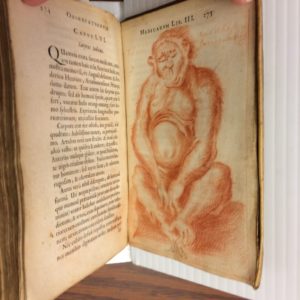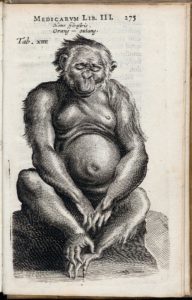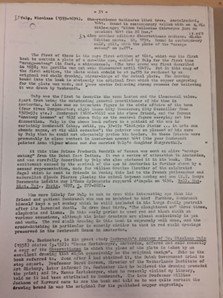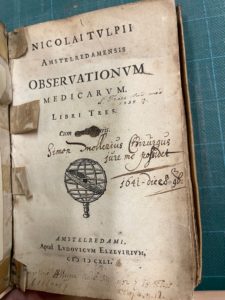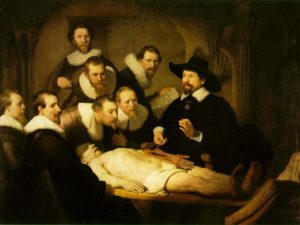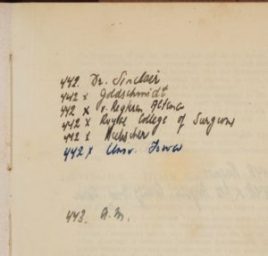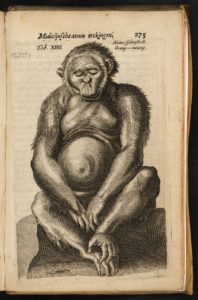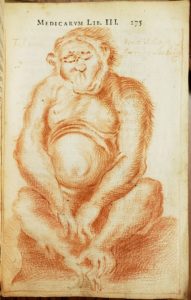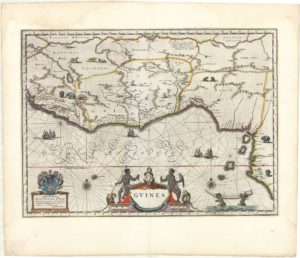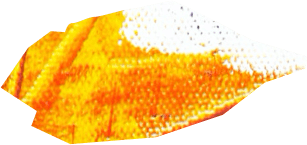|
A book by the prominent 17th-century Dutch physician and acquaintance of Rembrandt, Nicolaes Tulp, contains a print of an anthropoid ape. The University of British Columbia (UBC) Library owns a copy of the book in which an original red chalk drawing occupies the place of the engraving. Hugh Sinclair, its last private owner, believed it was the preparatory drawing for the print, and that it was drawn by Rembrandt. In this article we will examine the evidence and unravel a Rembrandt myth, which to this date has remained under the radar of Rembrandt specialists.
A drawing attributed to Rembrandt In 1965, the University of British Columbia (UBC) Library acquired the collection of historical medical books from the medical researcher Hugh Macdonald Sinclair (1910-1990).1 The purchase of this collection forms a significant portion of the Gibson Collection of Medicine and Science. An inventory, listing the contents of the 65 tea chests containing approximately 7000 books, accompanied the purchase.2 While most of the items in the list are brief records with some minor annotations prepared by the collector, Hugh Sinclair, there is one full page detailing his copy of the Observationum Medicarum of 1641, written by the Amsterdam physician and surgeon Nicolaes Tulp (1593-1674). In UBC’s copy of the first edition, there is an original red chalk drawing representing a seated ‘Orang-outang’ (Fig. 1) whereas in other copies of this edition, one finds a print of the same composition, in mirror image (Fig. 2).3 In his description, Sinclair presumes this drawing to be the original from which the engraving for the plate was made and argues that it was drawn by Rembrandt. However, the drawing, which is neither dated nor signed, has never been discussed in the literature on Rembrandt. Its existence has also never been signalled in the literature on the discovery of anthropoid apes, for which orangutan was a generic term until the end of the eighteenth century.
The birth of a Rembrandt myth A review of the Library’s acquisition files revealed that there was a great deal of press coverage concerning the acquisition and the Rembrandt claim. For example, UBC Reports, a newsletter of the university, made a big splash of the acquisition: A rare 1641 edition of a medical text by Nicholaas Tulp, physician to Rembrandt, which has been bound into it a red chalk drawing of a chimpanzee, allegedly by the great Dutch painter. The chalk drawing is the original used to make a copper engraving which is used to illustrate other copies of the Tulp book also in the collection.4 Other newspaper clippings and correspondence in the acquisition files pick up the claim. The Oxford Times (February 25, 1966) quotes Dr. Sinclair about the sale “… including a copy of Tulp’s Observations worth 3,000 pounds and containing a drawing attributed to Rembrandt”. An article in the Vancouver Sun (March 24, 1966) entitled, UBC has puzzle painting, reflects caution when quoting Dr. William Gibson (Professor and Head of the History of Medicine and Science Department): “We’re not making it a cause celebre” and explaining that the university had no plans to get experts to verify or disprove whether the drawing was an original Rembrandt.
Motivation to investigate further In 2017, while researching the Gibson Collection, Charlotte Beck, a librarian at UBC re-discovered Sinclair’s inventory of the collection he sold to UBC in 1965 and the note in the original catalogue record for Tulp’s Observationum Medicarum, “attributed by some to be by Rembrandt,” caught her attention. With Katherine Kalsbeek, Head of Rare Books and Special Collections, she began to investigate the basis for this attribution. Recently a new impulse arose at the UBC to investigate this matter further. At the Rembrandt House Museum in the summer of 2021 another copy of the 1641 edition of the Observationum Medicarum appeared in the exhibition Hansken. Rembrandt’s Elephant. Rembrandt was fascinated by unfamiliar animals from distant regions and his drawings of the elephant Hansken bear witness to this.5 A similar interest surfaces in Tulp’s book. Never before had such a human-like animal reached the European continent alive. The book was exhibited opened to the page with the engraving (Fig. 2). Next to it was a seventeenth-century map of Guinea in Africa, on which the same animal (actually a chimpanzee), appears in the same seated position. Nina Siegal reviewed the exhibition for The New York Times.6 Her piece caught the attention of Katherine Kalsbeek in Vancouver. She contacted Michiel Roscam Abbing, guest curator of the exhibition. The present article is the result of the collaborative research that followed.
In the last line of his description, Sinclair recalls a visit to his library by the “late Professor William Jackson of Harvard”. Jackson, at the time an internationally renowned bibliographer and a librarian at the Houghton Library, part of Harvard College Library, died in Boston on October 4, 1964, which implies that Sinclair wrote the inventory in connection to the sale. Sinclair begins his entry with a brief description of both editions of Tulp’s book in his possession, from 1641 and 1739 respectively.7 This is followed by an elaboration of the drawing in the earliest edition. Sinclair argues that the drawing should be attributed to Rembrandt. He had discussed this with scholars, including Professor Jackson. The entry is published here for the first time (Fig. 3): Tulp, Nicolaas (1593-1674). Observationum medicarum libri tres. Amstelredami, 1641. Bount in contemporary vellum with on title-page: “Simon Mollerius Chirurgus jure me possidet 1641 die 18 Nov.” Also another edition: Observationes medicae. Edition sexta. LB, 1739. Bound in contemporary calf, gilt, with the plate of the “orang-outang” on p. 271. The first of these is the rare first edition of 1641, which was the first book to contain a plate of a man-like ape, called by Tulp for the first time “orang-outang” (in fact, a chimpanzee). (The true orang was first described in 1658; the gorilla was not even discovered until 1847). But in this copy of the first edition, the plate which should be at p. 275 is replaced by an original red chalk drawing, mirror image of the actual plate. The drawing bound into the book is obviously the original from which the copper engraving for the plate was made, and there are the following strong reasons for believing it was drawn by Rembrandt. Tulp was the first to describe the vasa lactea and the ileocaecal valve. Apart from being the outstanding general practitioner of his time in Amsterdam, he also was an important figure in the civic affairs of the town (four times Burgomaster; eight times City Treasurer; City Councillor from 1629-53; etc.). Rembrandt (1606-1669) was his close friend, and the famous “Anatomy Lesson” of 1632 shows Tulp as the central figure carrying out the dissection. Tulp in the above book refers to a patient of his who is certainly Rembrandt (chap. XVIII, pp. 37-9): “Insignis Pictor … in arte sua abunde sagax, et vix ulli secundus”: the painter was so pleased of his cure by Tulp that he could not adequately praise his healer. So these friends were presumably in close contact in Amsterdam around 1641 (the year Rembrandt painted Anna Wijmer whose son Jan married Tulp’s daughter Margaretha). At this time Prince Frederik Hendrik of Nassau was sent an alive “orang-outang” from the Dutch East Indies. It was a centre of attraction in Amsterdam, and was carefully described by Tulp who also pictured it in his book. The excitement caused by the arrival of the ape in Amsterdam is further shown by a second representation, made for William Grotius (brother of the celebrated Hugo) which he sent to friends in Paris; this led to the French philosopher and naturalist Claude Peiresc placing the animal between monkey and man (E.T. Hamy: Documents inédits sur l’Homo Sylvestris rapporté d’Angola en 1630. Bull. Mus. Hist. Nat., Paris, 1897, 5, 277-282). Who more likely for Tulp to ask to draw this interesting ape than his friend and patient Rembrandt who was so indebted to him? Further, Rembrandt himself kept a pet monkey which he still included in his large family portrait after its lamented death. He drew dead birds, “The slaughtered ox” three times, elephants and lions. In this early period he used red and black chalk on various occasions, although his later drawings are almost exclusively in pen and wash. The red chalk drawing in this book is supremely well done, and the cross-hatching in particular is exactly similar to that in red chalk drawings preserved in the Rembrandt House in Amsterdam. Dr. Heckscher, in his great study Rembrandt’s Anatomy of Dr. Nicolaas Tulp (1958) states (p. 152): “Menno Hertzberger, Amsterdam, offered and sold recently a copy of the Observationes in which the place of the plate is taken by an excellent drawing that might conceivably be the original design”. This is the book referred to. Soon after I obtained it, the Dutch Government tried to stop export. Professor Horst Gerson, Director of the Netherlands Institute of Art History, later informed Dr. Heckscher that he believed the drawing preceded the print; and Dr. Menno Hertzberger, when he recently visited my library, told me it had been attributed to Rembrandt. The late Professor William Jackson of Harvard came to see the book and told me he was quite certain the drawing bound in was the original for the published copper engraving.
Claims made by others Sinclair does not say when he bought the book, but he does say from whom. The Amsterdam antiquarian Menno Hertzberger (1897-1982) specialized in historical medical publications. In his sales catalogue from 1954, the book is offered under lot 442 and the drawing is shown on page 71.8 In the catalogue Hertzberger gives the following detailed description: This engraving, representing an “orang outang” or chimpanzee, is replaced by a sketch in red chalk of the same subject in inversed sense. We have found no mention of any other copy having this feature. The drawing appears to be by a contemporary hand and, as such, might be the earliest in existence showing this animal and might have served for the engraving. Possibly it was made by the Surgeon Simon Mollerius, the first owner of the copy, whose autograph, dated 1641, is found on title together with two later ownership’s entries. As the catalogue entry notes, the book was bought in 1641 by Simon Mollerius, according to the ownership inscription dated November 28, 1641 (Fig. 4). Mollerius married IJtje Gerrits on 1 January 1633 in Amsterdam. He was 25 years old and came from Emden in Germany. In February 1642 Mollerius sold a house in the Oude Looiersstraat. On October 10, 1649 he was buried in the Westerkerk as “master Simon Mollerius” and living on the Prinsengracht. Surgeons took care of the sick and were allowed to perform simple medical treatments. They were trained by the Surgeons Guild. Mollerius undoubtedly attended Tulp’s lessons and he would have benefitted from the medical chapters in the book.
In 1958, art historian William S. Heckscher (1904-1999) published a monographic study on Rembrandt’s Anatomy Lesson of Dr. Nicolaes Tulp, now in the Mauritshuis (Fig. 5). In this study, Heckscher refers to the chimpanzee that Tulp describes, as well as the copy of the book sold by Hertzberger, and its drawing. Hertzberger’s own copy of the sales catalogue records six handwritten names in the margin of lot 442, five of which precede with a cross (Fig. 6).9 No doubt he sent a copy to these six, one of them “Heckscher”, assuming they might be interested in purchasing the book. The only name without a cross is the buyer, “Dr. Sinclair”. Heckscher received the sales catalogue and noted its assertion that the drawing might be the original after which the engraving was made.10 Hertzberger suggests that the drawing might have been made by the book’s first owner, the surgeon Mollerius. But here he contradicts himself: how could a drawing have been made by the first owner of the book if that same drawing served as an example of the engraving that should have been included in that book? Heckscher does not follow this suggestion and neither of them mention Rembrandt.
The assumption that the drawing was the model for the engraving was understandable though, because the drawing seems to be a mirror image of the engraving. According to Sinclair, the art historians he consulted were of that opinion. Horst Gerson (1907-1978), the then director of the Netherlands Institute for Art Historical Documentation, later informed Heckscher that he (also) believed that the drawing preceded the print. Professor William Jackson was likewise convinced that the drawing was the original from which the copper engraving was made. Sinclair does not mention that he was also in direct contact with Heckscher.11
A later owner of the copy had the drawing made Analysis of the binding of the book provides new insight into the genesis of the drawing. It is not pasted or bound as a separate sheet, but made on the sheet of paper on which the engraving should have been printed. This is easy to explain. Two print runs were required in 1641. In the first, the inscription and page number were printed in the lead type (“Medicarum Lib. III. 275”) and the space below was left blank for the second printing run. The second printing was necessary to print the image of the copper plate. In this specific case, only the first print run took place, and the copy was sold without the engraving of the described chimpanzee. A printer’s error. This means that the drawing could never have been made before 1641 and could never have been the original to which the engraving was made.
In the year after Mollerius’ death, in 1650, a Dutch translation of Tulp’s book entitled De drie boecken der medicijnsche aenmerkingen, was published. This was an unauthorized translation. Tulp had nothing to do with it, but was naturally vexed, and toward the end of his life produced his own translation from the Latin. It did not go to press, however, most likely because of Tulp’s death in 1674.12 Unsurprisingly, the Amsterdam bookseller who published the unauthorized translation, Jacob Benjamyn (c. 1624-1673), did not have at his disposal the copper plates that were used in 1641. These remained in Tulp’s possession and would be used for two subsequent Latin editions, in 1652 and in 1672, still during Tulp’s lifetime. They were also intended to be used to illustrate Tulp’s own, never-published translation.13 Benjamyn had very good copies made, which have never been used for any other edition. The engraving of the great ape is a mirror image of the engraving from 1641 (Fig. 7). The unknown draftsman of the chimpanzee in the copy that Sinclair bought from Hertzberger followed the engraving of the translated edition of 1650 to fill in the blank page with the missing image. We can be sure as he also took over the engraved text on both sides of the head, “Tab. XIIII” and “Homo sylvestris. Orang-outang,” exactly after the example he had before him (Fig. 8). So what can be concluded is that, after Mollerius’ death in 1649, in or after 1650, a later owner commissioned the illustration in red chalk. A second entry, dated October 18, 1682, shows that the book was then owned by Dethard Meppen (1656-1702), a lawyer who obtained his doctorate in Jena in 1677.14 It is unknown who owned the book between 1649 and 1682.
Sinclair’s hypotheses In theory the draftsman could still have been Rembrandt, since he died in 1669. Sinclair argued that Rembrandt was responsible for the drawing. He relates that Hertzberger had visited his library and assured him that the drawing was attributed to Rembrandt.15 However there is no evidence of any other scholar’s support of this view. Tulp’s description of one of his patients, an unnamed painter cured by him, leads Sinclair to unreservedly assume that that unnamed patient must be Rembrandt: “Who more likely for Tulp to ask and draw this interesting ape than his friend and patient Rembrandt who was so indebted to him?” Sinclair further states that shortly after purchasing the book, the Dutch government tried to stop its export. If there really was an attempt to ban export, it must have had to do with the attribution to Rembrandt. However, during our research in the National Archives in The Hague we were unable to confirm this event.16 Nor has any correspondence about this case with Sinclair been found in Menno Herzberger’s personal archive.17 In the Netherlands, the Cultural Heritage Preservation Act (Wet tot Behoud van Cultuurbezit) today the Heritage Act (Erfgoedwet) only came into effect in 1985. In the 1950s there was not even any legal basis to ban the export of such an item.18 The book collector achieves some traction when he points to drawings by Rembrandt in red chalk with a similar hatching. Sinclair states that drawings with cross-hatching that is ‘exactly similar’ are kept in the Rembrandt House Museum. However, there was and is not a single red chalk drawing by Rembrandt in the Museum’s collection. In 2021 Sinclair’s attribution was confidently rejected on stylistic grounds by Peter Schatborn, former head of the Rijksmuseum’s Print Room, one of world’s leading Rembrandt experts, and compiler of the most recent catalogue of Rembrandt’s drawings.19
The arrival of the anthropoid ape in Europe Tulp wrote in his report that the ‘Orang-outang’ was a gift to Stadholder Frederik Hendrik and, in his memory, came from Angola. He does not record the year he saw the animal. But Sinclair had found a publication stating that the ape arrived in Holland in 1630.20 He does not elaborate on this information however, and does not mention that Rembrandt was still living in Leiden at that time, and would only meet Tulp and paint the Anatomy Lesson in Amsterdam two years later. Ernst Brinck (1582-1649), the regent from Harderwijk who made notes about the elephant Hansken, also confirms 1630 as the year of the chimpanzee’s arrival. His notes specify that the ape arrived in Amsterdam and was brought by ships of the West India Company.21 It is unknown how long the animal lived. It is plausible that a portrait was made of the chimpanzee on its arrival in Amsterdam. In 1641 that portrait was available to Tulp who had an engraving made after it. No longer extant, this original had already been in the hands of the Amsterdam mapmaker Willem Jansz Blaeu (1571-1638). Blaeu’s map of Guinea from 1634, dedicated to Nicolaes Tulp, shows the sitting ape (Fig. 9).22 Sinclair was evidently unaware that the original portrait was known and published some seven years before publication of Tulp’s book.
Conclusion The long-standing myth that Rembrandt was the creator of this drawing seems to have originated with Hugh Sinclair himself. We can now conclude that the drawing in Sinclair’s book is a later version, made in or after 1650, after a copy of a copy of the original portrait of the chimpanzee that must have been made shortly after the animal’s arrival in Amsterdam in 1630. Based on our research, it is evident that the drawing in Sinclair’s book was commissioned by a later owner of the book and done by an unknown artist. Katherine Kalsbeek (BA, MLIS) has worked with UBC Library since 2004 and is currently the Head, Rare Books & Special Collections (RBSC). Michiel Roscam Abbing (1958) was awarded his doctorate at Amsterdam University with a thesis on Rembrandt documents, Rembrant toont syn konst (1999). He compiled a list of New Rembrandt documents (2006) and was guest-curator of the exhibition Hansken, Rembrandt’s elephant (2021) in the Rembrandt House Museum. Charlotte Beck, a reference librarian at Woodward Library, UBC, is the liaison for the rehabilitation sciences and as the history of science and medicine librarian has oversight for the Gibson collection. |
- On Sinclair: Jeannette Ewin, Fine Wines and Fish Oil: The Life of Hugh Macdonald Sinclair, Oxford 2001.
- The typescript is available in the “Library acquisition file for the Sinclair collection”.
- UBC Library, WZ250 .T9 1641.
- “7,000 rare books arrive”, UBC Reports 12, no. 3 (March-April, 1966). https://www.library.ubc.ca/archives/pdfs/ubcreports/UBC_Reports_1966_03_00.pdf
- Michiel Roscam Abbing, Rembrandt’s Elephant. Following in Hansken’s Footsteps, Amstelveen 2021.
- Nina Siegal, “When Rembrandt Met an Elephant”, The New York Times, July 16, 2021.
- UBC Library, WZ250 .T9 1641 and WZ260 .T83 1739 with the title Observationes Medicae.
- Allard Pierson, University of Amsterdam, Archives of Menno Hertzberger (UBA235). Sales catalogue Medicine Hippocrates-Claude Bernard, Amsterdam [February 1954], lot 442.
- Note 8 for this annotated copy.
- He also kept the relevant page from the catalogue in his files. Hamburg, Warburg Haus, Heckscher Archiv, Box 121 (‘Rembrandt: Dr. Tulp’), folder ‘Dr. Tulp Photo’s I’. Sinclair’s copy is kept in UBC Library call number Z999.74.
- According to Heckscher’s own administration he sent letters to Hugh Sinclair on 15 February and 2 March 1963. Hamburg, Warburg Haus, Heckscher Archiv, Box 52 (‘Heckscher: Korrespondenz und Arbeiten’). We thank Ms. Fanny Weidehaas of the Heckscher Archiv for her assistance. These letters were not found among Sinclair’s papers in The Museum of English Rural Life at the University of Reading. We thank Ms. Emma Farmer for checking these files.
- The translation was not published until 1991: Nicolaes Tulp, Geneesinzichten van Dr. Nicolaes Tulp etc., eds. (and transcriptions) C.G.L. Apeldoorn and T. Beijer. Amsterdam, 1991.
- The title page of the manuscript reads: “Nicolaes Tulp. Inzichten over de geneeskunst in vier boeken met koperen platen” (Nicolaes Tulp. Medical Insights in Four Books with Copper Plates).
- “D. Meppen Norda Frisii 1682 d. 18 8.bris”. We thank Koert van der Horst, retired keeper of manuscripts of the Utrecht University Library, for this identification. A third (unidentified) ownership’s inscription reads: “L. Fries stud. med. 1838 16/2.”
- The visit is not recorded in Sinclair’s Visitors book. Reading, The Museum of English Rural Life, Papers of Hugh Macdonald Sinclair, D HS 1/7/1: Visitor’s book 1941-1989: Dr Hugh Sinclair’s book of visitors to his home, Lady Place in Sutton Courtenay. We are grateful to Ms. Hollie Piff for checking.
- In the National Archives in The Hague we consulted the archives of the Department of Archeology and Nature Conservation, inv. no. 105 (Stukken betreffende de aanvraag van vergunningen voor de in- en uitvoer van voorwerpen van geschiedenis en kunst. 1946-1964).
- Allard Pierson, University of Amsterdam, Archives of Menno Hertzberger (UBA235), personal archives.
- Kindly provided information by Ms. Nina Duggen, Inspectie Overheidsinformatie en Erfgoed (Information and Heritage Inspectorate).
- Peter Schatborn and Erik Hinterding, Rembrandt. The Complete Drawings and Etchings, Cologne 2019. Peter Schatborn gave his judgement in an email of September 15, 2021, in translation: “In any case, the drawing was not made by Rembrandt. The stylistic differences are too great and I can’t find any drawing by Rembrandt that is comparable”.
- Ernest Theodore Hamy, ‘Documents inédits sur l’Homo sylvestris rapporté d’Angola en 1630′, Bulletin du Muséum d’histoire naturelle 3 (1897), pp. 277-282.
- Michiel Roscam Abbing is currently preparing a book-length study, The Ape of Tulp, in which these data are to be published.
- Peter van der Krogt and Erlend de Groot, The Atlas Blaeu-Van der Hem of the Austrian National Library V (Utrecht 2005), pp. 88-89 (no. 35:40). The suggestion that Blaeu, who died in 1638, had access to the engraving of the chimpanzee and that this engraving was made by Tulp long before 1641, as argued by Kees Zandvliet (De Wereld van de familie Blaeu, Zutphen 2023, p. 66) must be rejected.
